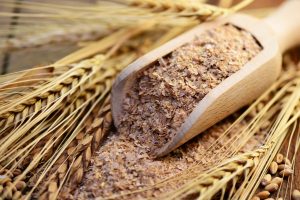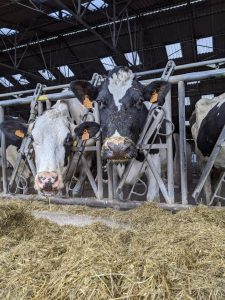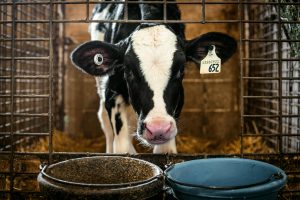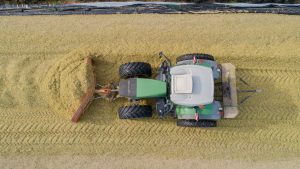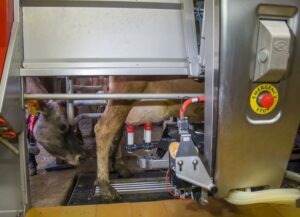Álvaro García
Citrus fruits, particularly oranges and lemons, are often available as byproducts from juice production or as surplus from orchards. These fruits have gained attention in livestock nutrition due to their palatability and potential benefits but feeding them to dairy cows involves certain challenges. The fruit pulp contains a high amount of water, making it highly palatable for dairy cows. However, the peel, although less palatable, is often included as part of the waste from juicing operations and has its own set of nutritional characteristics, including high fiber content and essential oils. These compounds can provide additional nutritional benefits but also create challenges when fed in excess. Whole fruits, when fresh, provide a good balance of simple carbohydrates (from sugars) and fiber, as well as some micronutrients. However, the ratio of pulp to peel varies, with peel content often constituting a larger portion of the fruit mass when considering waste by-products. The high moisture content of fresh citrus fruits can be both beneficial and problematic depending on the method of feeding and the animal’s digestive tolerance.
Constraints to Fresh Feeding
While citrus fruits can be a valuable supplement to the dairy cow diet, there are some constraints to feeding them fresh:
- Moisture: Fresh citrus fruits have a high-water content, often around 80-85%, which can lead to excess water intake if fed in large quantities. This can disrupt the cow’s rumen balance and lead to digestive disturbances or bloating. Additionally, high water intake without enough fiber can dilute the total dry matter intake (DMI), potentially affecting overall feed efficiency.
- Availability: The supply of fresh citrus fruits can be inconsistent, depending on local agricultural practices and seasonal variations. This can make fresh feeding less dependable year-round and may require alternative storage or preservation methods to ensure a steady supply.
- Transportation: Transporting fresh citrus fruits can be costly due to their perishability, and the fact that one is transporting a lot of water. The fruits must be moved quickly from the point of production to the farm, which requires refrigerated storage or swift transportation logistics. Additionally, the volume of fresh fruit needed to make a significant impact on a cow’s diet can make transportation less economical.
- Storage: Fresh citrus fruits and peels spoil quickly when not used immediately, leading to potential waste. They must be processed, fed, or preserved in a timely manner to avoid economic losses.
- Seepage: Seepage refers to the liquid lost from citrus fruits during storage or feeding. Due to their high moisture content, excess liquid can accumulate in feed troughs or storage containers or wash away soluble nutrients like sugars when left on the ground, reducing the nutritional value of the feed. Additionally, seepage can promote the growth of harmful bacteria, molds, or yeast, which can degrade feed quality and pose health risks to cows.
Ensiling Citrus Fruits
One way to mitigate the above challenges is by ensiling citrus fruits and peels. Ensiling helps preserve the nutritional value of citrus by preventing spoilage while maintaining the fruit’s moisture content. The fermentation process can also break down some of the fiber in the peel, making it more digestible for cows. However, ensiling citrus fruits presents some unique concerns, primarily because of the high moisture content. During the fermentation process, excess liquid may be released from the fruits, creating issues with nutrient loss and potential spoilage. Citrus waste is typically acidic, with its pH ranging from 3 to 4, which can inhibit the growth of certain harmful organisms. However, while the acidity may offer some protection against bacteria and molds, it does not fully prevent the development of all pathogens. For example, some molds, yeasts, and certain bacteria (like Salmonella or E. coli) can still thrive in acidic environments, especially if the waste is improperly stored or left in conditions that trap moisture, such as in piles. Management of ensiled citrus pulp needs to be designed to allow for proper drainage to manage excess liquid. This helps maintain the quality of the silage and prevents seepage from becoming a significant problem.
Citrus pulp is often ensiled with drier feeds like fibrous by-products to reduce its high moisture content (75-85%). This blending balances the moisture level, typically targeting 60-70%, which is ideal for ensiling. The dry feed ingredients enhance fermentation by providing fermentable sugars for lactic acid production, ensuring a rapid pH drop that preserves the silage and minimizes spoilage. Mixing also improves the nutritional balance, complementing the high energy and digestibility of citrus pulp with added fiber or protein from the dry feeds. Proper packing and airtight sealing are essential to create anaerobic conditions, while locally available dry feedstuffs help reduce costs. This practice not only manages moisture but also produces a nutrient-rich and cost-effective feed for livestock.
Optimal Feeding Amounts
Citrus fruits can be a useful supplement in the dairy cow diet. Studies have shown that citrus fruits and peels can be included at rates of about 5-10% of the total dry matter intake for dairy cows. This inclusion rate is often sufficient to provide the cows with added sugars, fiber, and micronutrients without overloading their digestive systems with excess water or unbalanced nutrient content.
When feeding citrus, it is important to monitor the total dry matter intake and ensure that the diet remains balanced. A diet that is too high in citrus could displace other necessary nutrients and lead to suboptimal performance in terms of milk production and overall health.
Excessive feeding of citrus fruits or citrus-based byproducts can have negative effects on dairy cow performance, particularly on milk yield and composition:
- Reduced Dry Matter Intake (DMI): Due to the high moisture content of citrus, feeding excessive amounts may reduce the total dry matter intake. This could result in a lower energy intake, which can reduce milk yield. A decrease in DMI may also impair the cow’s overall health, making it more prone to metabolic disorders.
- Imbalance in Nutrient Intake: Overfeeding citrus fruits may cause an imbalance in the cow’s diet, particularly in relation to the carbohydrate-to-protein ratio. The high sugar content of citrus fruits, when fed in excess, could disrupt the cow’s rumen fermentation process, leading to a decrease in fiber digestion and an increase in the risk of acidosis.
- Milk Yield and Composition: Excessive feeding of citrus can lead to changes in milk composition. Elevated levels of citric acid in the diet may lower the pH in the rumen, potentially affecting the cow’s ability to digest fiber properly. This can result in reduced milk yield and lower fat and protein percentages in milk. Furthermore, cows consuming too much citrus may produce milk with off-flavors due to the high citric acid content.
- Rumen Acidosis: If citrus fruits are fed in substantial amounts, their high sugar content could cause rapid fermentation in the rumen, leading to an accumulation of volatile fatty acids (VFAs) and a drop in rumen pH.
Feeding citrus fruits such as oranges and lemons to dairy cows offers certain nutritional benefits, including a good source of sugars, fiber, and vitamins. However, several factors need to be considered when incorporating them into a cow’s diet. These include logistical constraints related to fresh feeding, spoilage issues, and transportation challenges. Ensiling citrus fruits provides an excellent way to preserve their value and reduce spoilage, but attention must be given to seepage and moisture management during ensiling.
When fed in moderation (5-10% of total dry matter intake), citrus fruits can improve dairy cow nutrition without causing significant disruptions to milk yield or composition. However, excess feeding should be avoided to prevent rumen acidosis, reduced DMI, and changes in milk composition.
For dairy farmers, the key to successfully incorporating citrus into their feeding program lies in balancing the amount fed with the overall nutritional needs of the cows and carefully monitoring their health and milk production. Proper storage, handling, and incorporation into the total diet, while managing issues like seepage, are essential for maximizing the benefits of citrus feeding.
© 2025 Dellait Knowledge Center. All Rights Reserved.



